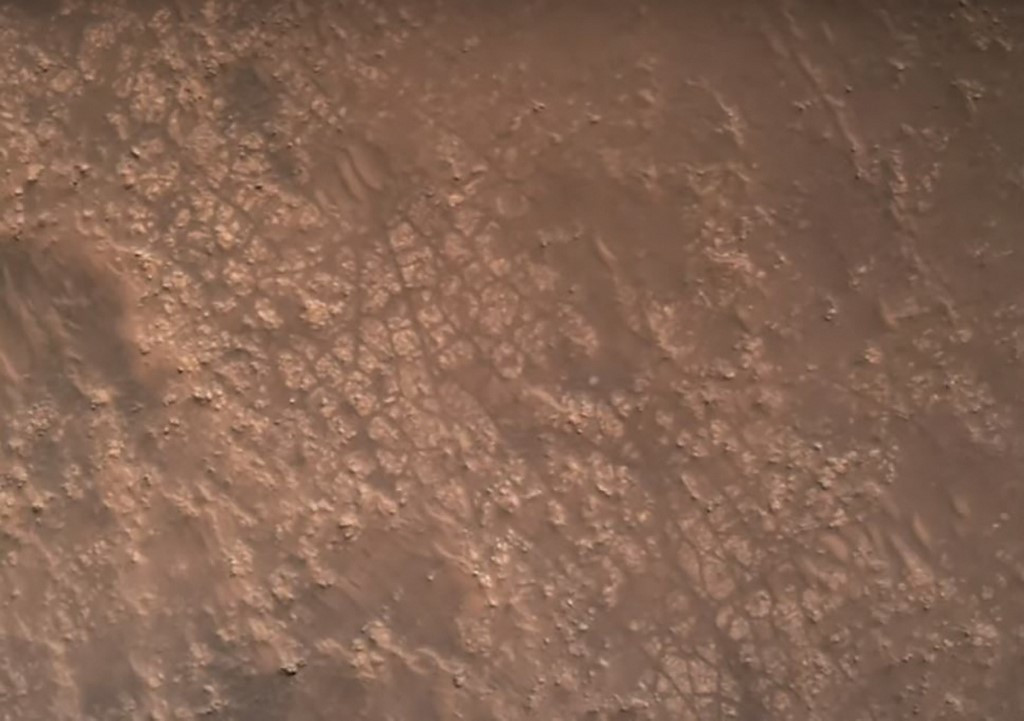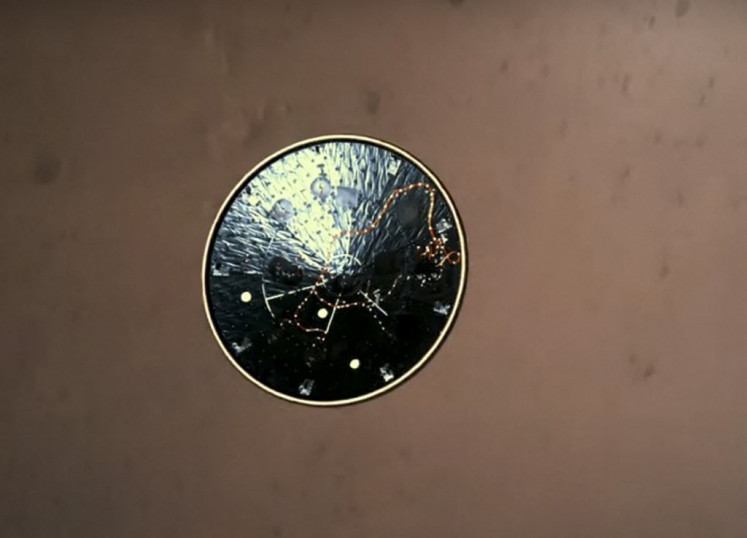Popular Reads
Top Results
Can't find what you're looking for?
View all search resultsPopular Reads
Top Results
Can't find what you're looking for?
View all search resultsNASA rover provides landing images on Mars, sound of Martian breeze
Along with 3 minutes of footage of what it calls "the world's most intimate view of a Mars landing," the U.S. space agency also released an audio recording of sounds from the red planet, including what it said was a wind gust on the surface of Mars.
Change text size
Gift Premium Articles
to Anyone
 This NASA video frame grab photo released on February 22, 2021 shows the surface of Mars, NASA's Mars 2020 Perseverance mission captured in footage of its rover landing in Mars' Jezero Crater on February 18, 2021, the real footage in this video was captured by several cameras that are part of the rover's entry, descent, and landing suite, the views include a camera looking down from the spacecraft's descent stage (a kind of rocket-powered jet pack that helps fly the rover to its landing site), a camera on the rover looking up at the descent stage, a camera on the top of the aeroshell (a capsule protecting the rover) looking up at that parachute, and a camera on the bottom of the rover looking down at the Martian surface. The US space agency NASA on February 22, 2021 released the first video of the landing of the Perseverance rover on Mars. The video clip, lasting three minutes and 25 seconds, showed the deployment of the parachute and the rover's touchdown on the surface of the Red Planet. "These are really amazing videos," said Michael Watkins, director of NASA's Jet Propulsion Laboratory. "This is the first time we've ever been able to capture an event like the landing on Mars." (Agence France Presse/NASA)
This NASA video frame grab photo released on February 22, 2021 shows the surface of Mars, NASA's Mars 2020 Perseverance mission captured in footage of its rover landing in Mars' Jezero Crater on February 18, 2021, the real footage in this video was captured by several cameras that are part of the rover's entry, descent, and landing suite, the views include a camera looking down from the spacecraft's descent stage (a kind of rocket-powered jet pack that helps fly the rover to its landing site), a camera on the rover looking up at the descent stage, a camera on the top of the aeroshell (a capsule protecting the rover) looking up at that parachute, and a camera on the bottom of the rover looking down at the Martian surface. The US space agency NASA on February 22, 2021 released the first video of the landing of the Perseverance rover on Mars. The video clip, lasting three minutes and 25 seconds, showed the deployment of the parachute and the rover's touchdown on the surface of the Red Planet. "These are really amazing videos," said Michael Watkins, director of NASA's Jet Propulsion Laboratory. "This is the first time we've ever been able to capture an event like the landing on Mars." (Agence France Presse/NASA)
N
ASA on Monday unveiled high-definition video images of the final minutes of its rover touchdown on Mars last week, showing the explosive opening of a parachute and the landing rockets' plume stirring up red dust.
Along with 3 minutes of footage of what it calls "the world's most intimate view of a Mars landing," the US space agency also released an audio recording of sounds from the red planet, including what it said was a wind gust on the surface of Mars.
The footage, other images and audio recordings are "the closest you can get to landing on Mars without putting on a pressure suit," Thomas Zurbuchen, NASA associate administrator for science, said at an online press conference.
A spacecraft carrying the Perseverance rover, about the size of a small car, was launched on July 30 last year for a mission to look for signs of ancient life on the planet and collect rock samples to be returned to Earth by a future NASA mission.
This NASA video frame grab photo released on February 22, 2021 shows what NASA's Mars 2020 Perseverance mission captured in footage of its rover landing in Mars' Jezero Crater on February 18, 2021, the real footage in this video was captured by several cameras that are part of the rover's entry, descent, and landing suite, the views include a camera looking down from the spacecraft's descent stage (a kind of rocket-powered jet pack that helps fly the rover to its landing site), a camera on the rover looking up at the descent stage, a camera on the top of the aeroshell (a capsule protecting the rover) looking up at that parachute, and a camera on the bottom of the rover looking down at the Martian surface. The US space agency NASA on February 22, 2021 released the first video of the landing of the Perseverance rover on Mars. The video clip, lasting three minutes and 25 seconds, showed the deployment of the parachute and the rover's touchdown on the surface of the Red Planet. "These are really amazing videos," said Michael Watkins, director of NASA's Jet Propulsion Laboratory. "This is the first time we've ever been able to capture an event like the landing on Mars." (Agence France Presse/NASA). Usage: 0 (Agence France Presse/NASA)The landing took place on Thursday, with five commercial off-the-shelf cameras located on three different spacecraft components collecting the imagery. There was another camera, but it stopped operating, according to the National Aeronautics and Space Administration.
The imagery showed the parachute, about 22 meters in diameter, inflating after the spacecraft's entry to the Martian atmosphere, as well as dust and small rocks kicking up as the rover descended to the surface with the help of its rocket-powered jet pack.
NASA also showed the Mars mission's first panorama of the rover's landing location on the Jezero Crater, which scientists believe was home to a lake about 3.5 billion years ago as well as to an ancient river delta.
"These scenes look familiar to us. They look Earth-like in a sense. You know, you see the mountains back there, and the rocks and things. It really is the surface of an alien world and we just arrived," Justin Maki, an imaging scientist at NASA, said at the same press conference.
Mars, now a desert planet, is believed to have been more similar to Earth billions of years ago, with water on its surface, warmer temperatures and a thicker atmosphere.











